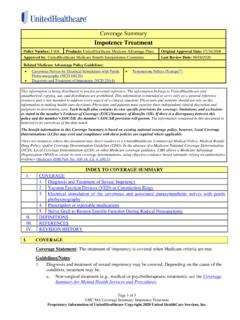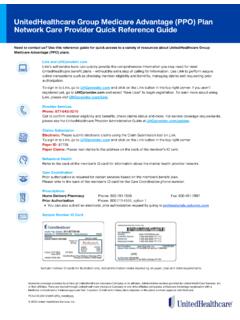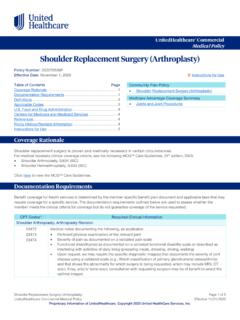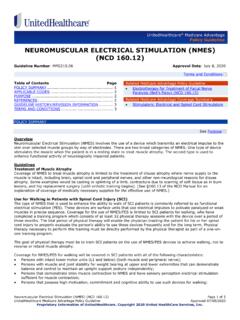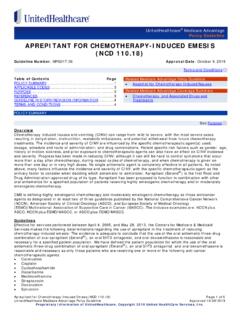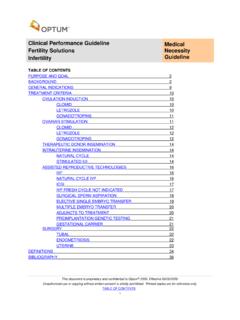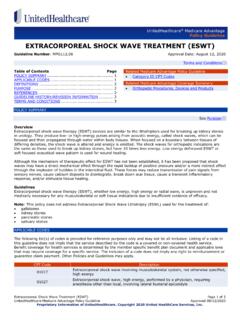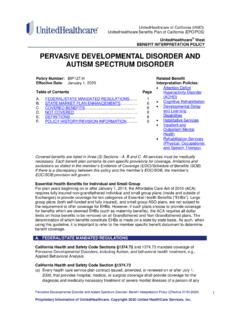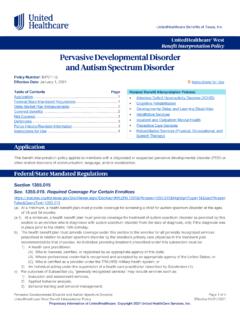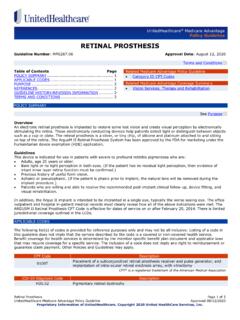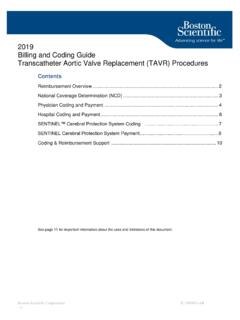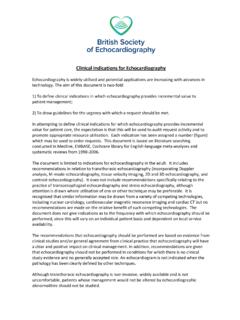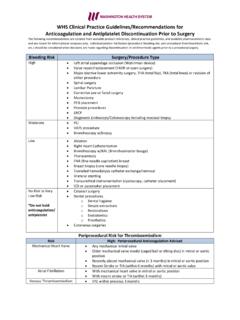Transcription of Transcatheter Heart Valve Procedures - UHCprovider.com
1 Transcatheter Heart Valve Procedures Page 1 of 35 UnitedHealthcare Commercial Medical Policy Effective 03/01/2022 Proprietary Information of UnitedHealthcare. Copyright 2022 United HealthCare Services, Inc. UnitedHealthcare Commercial Medica l Policy Transcatheter Heart Valve Procedures Policy Number: 2022T0557X Effective Date: March 1, 2022 Instructions for Use Table of Contents Page Coverage Rationale .. 1 Documentation Requirements .. 2 Definitions .. 3 Applicable Codes .. 4 Description of Services .. 5 Benefit Considerations .. 7 Clinical 7 Food and Drug 23 References .. 27 Policy History/Revision Information .. 34 Instructions for 34 Coverage Rationale See Benefit Considerations Aortic Transcatheter aortic Heart Valve replacement is proven and medically necessary when performed according to Food and Drug Administration (FDA) labeled indications, contraindications, warnings and precautions and all of the following criteria are met: Diagnosis of severe calcific native aortic Valve stenosis as indicated by one of the following: o Mean aortic Valve gradient 40 mmHg; or o Peak aortic jet velocity m/s.
2 Or o Aortic Valve area of cm2 Individual is symptomatic (New York Heart Association [NYHA] class II or greater) and symptoms are due to aortic Valve stenosis Individual does not have a congenitally bicuspid aortic Valve An interventional cardiologist and an experienced cardiothoracic surgeon have determined that the procedure is appropriate Individual has engaged in a Shared Decision Making conversation with an interventional cardiologist and an experienced cardiothoracic surgeon Procedure is performed in a center that meets all of the following criteria: o On-site Heart Valve surgery and interventional cardiology programs; and o Post-procedure intensive care unit with personnel experienced in managing individuals who have undergone open- Heart Valve Procedures ; and o Volume Requirements consistent with the Centers for Medicare and Medicaid Services (CMS); for additional information, see corresponding CMS National Coverage Determination and the Society of Thoracic Surgeons/American College of Cardiology (STS/ACC) Transcatheter Valve Therapy (TVT) Registry.
3 Community Plan Policy Transcatheter Heart Valve Procedures Medicare Advantage Coverage Summary Transcatheter Heart Valve Procedures Transcatheter Heart Valve Procedures Page 2 of 35 UnitedHealthcare Commercial Medical Policy Effective 03/01/2022 Proprietary Information of UnitedHealthcare. Copyright 2022 United HealthCare Services, Inc. Transcatheter Valve -in- Valve (ViV) replacement within a failed bioprosthetic aortic Valve is proven and medically necessary for individuals at high or prohibitive surgical risk (Predicted Risk of Mortality [PROM] score of 8%) when performed according to FDA labeled indications, contraindications, warnings and precautions. Note: Requests for Transcatheter aortic Heart Valve replacement for low-flow/low-gradient aortic stenosis will be evaluated on a case-by-case basis. mitral Transcatheter mitral Valve repair is proven and medically necessary when used according to FDA labeled indications, contraindications, warnings and precautions in individuals with one of the following clinical indications for intervention: Primary (degenerative) mitral regurgitation (MR) when all of the following criteria are met: o Moderate-to-severe or severe MR (grade 3); and o Symptomatic NYHA class III or IV; and o Prohibitive surgical risk as defined by ONE of the following: PROM score of 8% for individuals deemed likely to undergo mitral Valve replacement; or PROM score of 6% for individuals deemed likely to undergo mitral Valve repair ; or Predicted risk of death or major morbidity at 1 year of over 50%.
4 And o Care directed by a multidisciplinary Heart team which includes a Heart failure specialist, interventional cardiologist and cardiothoracic surgeon experienced in the evaluation and treatment of Heart failure and mitral Valve disease. Secondary (functional) MR when all of the following criteria are met: o Moderate-to-severe or severe MR (grade 3) with left ventricular ejection fraction (LVEF) 20 and 50; and o Symptomatic NYHA class II IV (ambulatory); and o Optimal evidence-based management which includes pharmacologic therapy plus cardiac resynchronization therapy as indicated; and o High surgical risk (PROM score of 8%); and o Care directed by a multidisciplinary Heart team which includes a Heart failure specialist, interventional cardiologist and cardiothoracic surgeon experienced in the evaluation and treatment of Heart failure and mitral Valve disease.
5 Pulmonary Transcatheter pulmonary Heart Valve replacement, using the Melody or Sapien valves , is proven and medically necessary, when used according to FDA labeled indications, contraindications, warnings and precautions, in individuals with right ventricular outflow tract (RVOT) dysfunction with one of the following clinical indications for intervention: Moderate or greater pulmonary regurgitation; and/or Pulmonary stenosis with a mean RVOT gradient 35 mmHg The following Transcatheter Heart Valve devices and/or Procedures are unproven and not medically necessary due to insufficient evidence of efficacy: Cerebral protection devices ( , Sentinel ) mitral Valve repair , reconstruction or replacement, except where noted above Tricuspid Valve repair , reconstruction or replacement Valve -in- Valve (ViV) replacement within a failed bioprosthesis for mitral , pulmonary, or tricuspid valves Transcatheter pulmonary Heart Valve replacement using the Harmony Valve Documentation Requirements Benefit coverage for health services is determined by the member specific benefit plan document and applicable laws that may require coverage for a specific service.
6 The documentation requirements outlined below are used to assess whether the member meets the clinical criteria for coverage but do not guarantee coverage of the service requested. Transcatheter Heart Valve Procedures Page 3 of 35 UnitedHealthcare Commercial Medical Policy Effective 03/01/2022 Proprietary Information of UnitedHealthcare. Copyright 2022 United HealthCare Services, Inc. CPT Codes* Required Clinical Information Transcatheter Heart Valve Procedures 33361 33362 33363 33364 33365 33366 33369 33477 For all Transcatheter Valve Procedures , provide medical notes documenting the following, when applicable: Name of device being used, if available Diagnosis Co-morbidities Treatments tried, failed, or contraindicated Physician treatment plan In addition to the above, provide medical notes documenting the following for: Aortic Heart Valve o New York Heart Association (NYHA) Classification o One of the following.
7 Mean aortic Valve gradient Peak aortic jet velocity Aortic Valve area o Member surgical status related to bicuspid aortic value procedure(s) o Member has engaged in a shared decision-making conversation with an interventional cardiologist and an experienced cardiothoracic surgeon who have determined procedure is appropriate o Facility where procedure will be performed Aortic Transcatheter Valve -in- Valve (ViV) Replacement o Name of failed device o Surgical risk using PROM score Pulmonary Heart Valve o Right ventricular outflow tract (RVOT) gradient or pulmonary regurgitation rate *For code descriptions, see the Applicable Codes section. Definitions CMS Volume Requirements for Transcatheter Aortic Heart Valve Replacement (TAVR): To begin a TAVR program for hospitals without TAVR experience, the hospital program must have the following: 50 open Heart surgeries in the previous year prior to TAVR program initiation; and 20 aortic Valve related Procedures in the 2 years prior to TAVR program initiation; and 2 physicians with cardiac surgery privileges; and 1 physician with interventional cardiology privileges; and 300 percutaneous coronary interventions per year.
8 To begin a TAVR program for Heart teams without TAVR experience, the Heart team must include: Cardiovascular surgeon with 100 career open Heart surgeries of which 25 are aortic Valve related; and Interventional cardiologist with: o Professional experience of 100 career structural Heart disease Procedures ; or, 30 left-sided structural Procedures per year; and o Device-specific training as required by the manufacturer. For hospital programs with TAVR experience, the hospital program must maintain the following: 50 aortic Valve replacements (TAVR or surgical aortic Valve replacement [SAVR]) per year including 20 TAVR Procedures in the prior year; or 100 aortic Valve replacements (TAVR or SAVR) every 2 years, including 40 TAVR Procedures in the prior 2 years; and 2 physicians with cardiac surgery privileges; and 1 physician with interventional cardiology privileges; and 300 percutaneous coronary interventions per year.
9 Transcatheter Heart Valve Procedures Page 4 of 35 UnitedHealthcare Commercial Medical Policy Effective 03/01/2022 Proprietary Information of UnitedHealthcare. Copyright 2022 United HealthCare Services, Inc. (CMS National Coverage Determination [NCD] for TAVR) New York Heart Association (NYHA) Heart Failure Classification (NYHA, 1994): I: No limitation of physical activity. Ordinary physical activity does not cause undue fatigue, palpitation, dyspnea or anginal pain. II: Slight limitation of physical activity. Comfortable at rest. Ordinary physical activity results in fatigue, palpitation, dyspnea or anginal pain. III: Marked limitation of physical activity. Comfortable at rest. Less than ordinary activity causes fatigue, palpitation, dyspnea or anginal pain. IV: Unable to carry on any physical activity without discomfort.
10 Symptoms of Heart failure at rest. If any physical activity is undertaken, discomfort increases. Predicted Risk of Mortality (PROM): The Society of Thoracic Surgeons (STS) PROM score is a predictor of 30-day mortality after cardiac Procedures (Otto et al., 2020). Shared Decision-Making (SDM): SDM is a process by which physicians and individuals work together to choose the treatment option that best reflects the clinical evidence and the individual s values and preferences (Coylewright et al., 2020). Applicable Codes The following list(s) of procedure and/or diagnosis codes is provided for reference purposes only and may not be all inclusive. Listing of a code in this policy does not imply that the service described by the code is a covered or non-covered health service. Benefit coverage for health services is determined by the member specific benefit plan document and applicable laws that may require coverage for a specific service.
